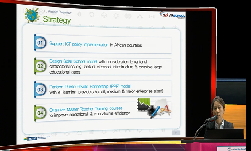This study examined elementary school teachers' perceptions of multicultural education. The sample for the study consisted of 63 elementary school teachers in an urban school system in the South. The subjects completed a Multicultural Attitude Surv...
http://chineseinput.net/에서 pinyin(병음)방식으로 중국어를 변환할 수 있습니다.
변환된 중국어를 복사하여 사용하시면 됩니다.
- 中文 을 입력하시려면 zhongwen을 입력하시고 space를누르시면됩니다.
- 北京 을 입력하시려면 beijing을 입력하시고 space를 누르시면 됩니다.
https://www.riss.kr/link?id=T10578157
- 저자
-
발행사항
[S.l.]: The University of Mississippi 2002
-
학위수여대학
The University of Mississippi
-
수여연도
2002
-
작성언어
영어
- 주제어
-
학위
Ed.D.
-
페이지수
100 p.
-
지도교수/심사위원
Director: Lucinda Leigh.
-
0
상세조회 -
0
다운로드
부가정보
다국어 초록 (Multilingual Abstract)
The subjects completed a Multicultural Attitude Survey that consisted of nineteen statements scored on a Likert scale, one multiple-choice question about the teachers' perceived levels of implementation of multicultural education, and a form which requested demographic information about each subject.
The results of this study were based on 63 teachers' perceptions of multicultural education, and their perceptions of the level at which they implemented multicultural education. The results indicated that there were no significant relationships between teachers' perceptions and the diversity of their classes, their ages, years of teaching experience, gender, or ethnic backgrounds. In addition, there was no significant relationship between teachers' perceptions and the level at which they perceived that they implemented multicultural education. Pearson r and Spearman rho correlations were used to analyze data.
Although there were no significant relationships found, the scores on the teachers' perceptions survey indicated that all subjects in this study possessed a positive perception of multicultural education. The majority of subjects also implemented multicultural education at Banks' two lowest levels of integration of ethnic content. Those two levels are the Contributions Approach where the teacher focuses on heroes and holidays, and the Additive Approach where the teacher adds a book or unit to the curriculum without changing the structure of the curriculum.
This study examined elementary school teachers' perceptions of multicultural education. The sample for the study consisted of 63 elementary school teachers in an urban school system in the South.
The subjects completed a Multicultural Attitude Survey that consisted of nineteen statements scored on a Likert scale, one multiple-choice question about the teachers' perceived levels of implementation of multicultural education, and a form which requested demographic information about each subject.
The results of this study were based on 63 teachers' perceptions of multicultural education, and their perceptions of the level at which they implemented multicultural education. The results indicated that there were no significant relationships between teachers' perceptions and the diversity of their classes, their ages, years of teaching experience, gender, or ethnic backgrounds. In addition, there was no significant relationship between teachers' perceptions and the level at which they perceived that they implemented multicultural education. Pearson r and Spearman rho correlations were used to analyze data.
Although there were no significant relationships found, the scores on the teachers' perceptions survey indicated that all subjects in this study possessed a positive perception of multicultural education. The majority of subjects also implemented multicultural education at Banks' two lowest levels of integration of ethnic content. Those two levels are the Contributions Approach where the teacher focuses on heroes and holidays, and the Additive Approach where the teacher adds a book or unit to the curriculum without changing the structure of the curriculum.
분석정보
연관 공개강의(KOCW)
-

Education Policy at the Party Conferences
Teachers TV Teachers TV -

2014 이러닝 국제 콘퍼런스 : What is the Lessons from Education Support Project~
한국교육정보진흥협회 Boseon, Kim -

Early Sex Education: The Debate
Teachers TV Teachers TV -

Alcohol Education: Here's What We Want
Teachers TV Teachers TV -

Personal Finance Education: The Money Quiz
Teachers TV Teachers TV






